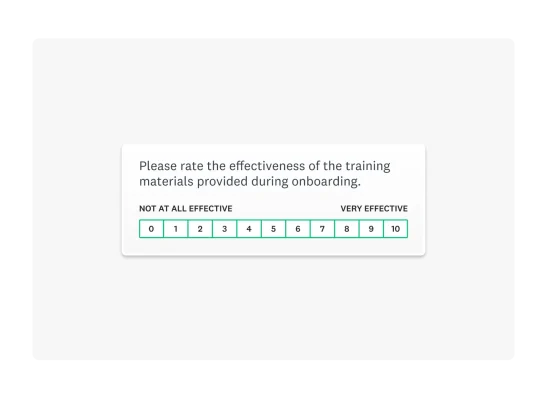30+ training survey questions and best survey design practices
Use these example training survey questions and design tips to create impactful and transformative surveys.

The world is changing rapidly with new technologies and globalisation, making learning and development a higher priority than ever.
Most people have taken some form of knowledge and skills training in their lifetime. New employees attend new hire training to acquire the skills they need to navigate their new workplace. A job function may require extra training to develop new skills or refresh existing ones for certification.
Training differs significantly from traditional courses, with participants expecting immediate improvements in their abilities after sessions. Surveys are essential tools for measuring training effectiveness and participant engagement. With the right training survey questions, you can assess your training effectiveness and decide where adjustments are needed.
What is a training survey?
Training surveys collect feedback from participants before and after sessions, allowing you to assess effectiveness and identify areas for improvement. You can also use the data to improve future training.
- Pre-training surveys can measure the participants’ existing knowledge or help manage their expectations of the training sessions. The survey data can help you plan that training material and assist with implementation.
- Post-training surveys help you see whether your training session met expectations, provided value to participants and was effective.
- Training feedback survey questions collect detailed feedback about the training session itself.
- Training effectiveness survey questions assess whether the course content achieved its intended outcomes and had a lasting impact.
Why training surveys matter
Training surveys for organisations and employees offer a host of benefits. They allow organisations to improve their training programmes and retain effective employees. The reality is that your employees want quality training.
According to a SurveyMonkey Audience survey, approximately 86% of employees say that job training is important to them. Most employees are even willing to spend out-of-office time on training. Your programming needs to be extremely effective to take full advantage of this training opportunity.
These surveys help you gather feedback, measure effectiveness and shape future training initiatives. Training surveys:
- Invest in employee knowledge
- Gather measurable learning outcomes
- Track how training impacts employee performance
- Pinpoint areas in need of improvement
- Increase employee engagement
30+ training survey questions examples
Identifying which questions to ask in a training survey is challenging. These questions must be tuned to your audience and deliver actionable data. Use the following example questions to create effective surveys.
1. Pre-training survey questions
Pre-training survey questions help you gather information about running successful training sessions. You’ll find out:
- What training is needed and whether there are any knowledge gaps that you need to fill
- The learning expectations of participants, so you can align training with their expectations
- The demographics of the group that you are presenting to, such as whether they work full- or part-time, their job title and job duties
- What special needs participants may have that require assistive equipment or training delivery
- Preferences for how you instruct the training, such as video for visual learners, lectures for auditory learners and demonstrations for tactile learners
- Any knowledge gaps with the training material so you can focus on areas for improvement and avoid redundancies
Demographics help you understand your audience, their available time commitment and their place in your organisation. It is unnecessary to ask intrusive demographic questions about aspects such as ethnicity, gender identification or age unless they are relevant to the training subject.
With this information, you can structure your training appropriately to ensure that the needs of your group are met effectively.
Example pre-training questions
- What do you hope to learn from this training?
- What is your current confidence level in using [specific skill/tool]?
- Have you previously attended similar training sessions?
- Do you work full-time or part-time?
- If there is one thing that you would like this course to cover, what would it be?
- Are you a visual learner?
- Do you prefer to learn via lectures or hands-on sessions?
- Do you require any additional support or accommodations to take this training?
2. Post-training survey questions
Post-training surveys measure the outcomes of your training sessions. You can determine whether you achieved your training goals and use the data to inform your next training session. Analysing your post-survey data will offer valuable insights into planning future training sessions.
With a post-training survey, you will discover:
Which training sessions were popular
If a particular training session is well attended or positively rated by attendees, evaluate whether it is a necessary part of your training schedule. Popular training can be updated and offered more regularly. For this, simply ask:
- Did you attend this training course in its entirety?
- Would you recommend this training to a peer?
Which instructors or trainers attract the highest numbers
This is a good indicator of the most informative and effective trainers. This should be your impetus to find out what they do differently from other instructors so that you can offer feedback and improvement opportunities to all trainers. Ask questions such as:
- How effective was the trainer in terms of delivering the material?
- Did the trainer provide clear instructions throughout the session?
- Was the trainer engaging and supportive?
Any barriers to learning
Was there anything that prevented the group from fully engaging in the training? If so, identify the barriers and strategies for overcoming them. Ask questions such as:
- Did you have any trouble with the size or readability of the font?
- Did you have difficulty interpreting or understanding any communications?
- Was the training location accessible?
- Did you find the training material practical, intuitive and helpful?
Adjustments to improve future sessions
Analysing your data should reveal what improvements you can make to your future training sessions to make them more informative, effective and attractive to attendees. Ask questions such as:
- Did the training cover the material in sufficient detail or did it only cover the basics?
- What do you wish the training would have explored more?
- What could be improved in future sessions?
Whether needs were met
Ask post-training knowledge questions to assess whether participants acquired the knowledge or skills identified in your training goals. Ask questions such as:
- Was the training content relevant to your job?
- Overall, did the course meet your expectations?
- Did you feel competent and confident in your grasp of the subject matter of this course at the end of the training programme?
- Were you able to get answers to all your questions during the training?
3. Training feedback survey questions
The purpose of training feedback survey questions is to gather specific feedback about the session. These surveys cover the:
- Quality of training materials, delivery and organisation
- Usefulness of activities and examples
- Trainer’s ability to engage participants
This includes asking about the feelings associated with undergoing the training and how well the employee felt the training went.
Example training feedback questions
- How engaging were the group activities or discussions?
- Were the learning objectives clearly defined and met?
- Was the training pace appropriate for the topic?
- How effective was the instructor at managing conflict?
4. Training effectiveness survey questions
These surveys measure whether the training achieved its intended outcomes and had a lasting impact. A training effectiveness survey should be administered a few weeks or months after completion. This gives participants time to apply the training in their daily work.
This survey will assess changes in participants’ knowledge, skills or behaviour over time, the applicability of training to job performance and the training programme’s ROI (return on investment).
Example training effectiveness questions
- How have you applied what you learned in your role?
- Have you noticed an improvement in your performance since the training?
- Did the training contribute to achieving your team’s goals?
- How has the training improved your productivity?
6 training feedback surveys best practices
These surveys explore what training to offer, the effectiveness of the training you’re delivering and whether students feel they are acquiring the skills they desire. Use the following six tips to craft effective feedback questions that ensure actionable insights.
1. Pre-training and post-training skills assessment
Pre-training skills assessments should be run before training sessions. They will establish what your participants already know, their expectations for the training and any learning needs and preferences. This information can be used to determine how you run the training, information delivery methods and content.
Pre-training skills assessments should determine participants’ prior knowledge, training expectations and learning preferences. The data from this survey can be used to find learner satisfaction and experience with the training. Our training course evaluation template is a great place to start.
Compare data from pre- and post-training skills assessments to assess learning gains from your training.
2. Ongoing progress towards goals
Poll individuals at the outset of a longer training programme to baseline where they are in relation to their goals. Throughout training, ask students to assess their progress. Deliver your survey on mobile devices in the training environment for near real-time feedback or on social media to broadcast their achievements to their network.
3. Trainee satisfaction with the course or programme
Find out whether the training you’re delivering is engaging and effective. Are you meeting the expectations of participants? Are they getting the instruction or information that they thought they would? Use this feedback for continuous improvement.
4. Instructor or teacher effectiveness
Two trainers might deliver the same course material quite differently, and that diversity allows you to attract more students. Nevertheless, you still need to know that all trainers can deliver training. Use surveys to gather students’ opinions of teacher effectiveness.
Kick off your instructor evaluations with our course evaluation survey template and our University Instructor Evaluation Survey Template. Take a look at our education surveys for other ways to lead assessments.
5. Career training and development
What do students or employees think about your organisation’s job training and development programmes? Do the offerings support their career goals and ambitions? Which education programmes do they need in order to achieve their objectives?
Find out whether your company is providing ample training for employees to learn and grow on the job. Use our career development survey template as a starting point to determine whether you are helping employees reach their full potential.
6. Training needs and opportunities
Could older people in your community benefit from a hands-on technology course? Are newbie parents interested in parenting classes? Utilise surveys in your community, workplace or fitness organisation to inform classes and training for your residents, employees, patients or clients.
Test potential offerings using SurveyMonkey Audience, which gives you access to millions of respondents similar to your target audiences.
How to conduct a training survey (5 steps)
Use this step-by-step guide to create and implement training surveys.
1. Define your goals

First, you must identify what you want to evaluate. Let’s suppose you’ve started a new process for employee onboarding training and need to determine how effective your new programme is.
Your goals may be to:
- Determine whether the new programme is more or less effective than the previous programme
- Determine whether the new programme has a high enough ROI to justify the cost
In order to achieve these goals, the entire survey and delivery process needs to be crafted with the result in mind.
2. Select your tools
Use online tools such as SurveyMonkey or similar platforms. With SurveyMonkey, you have access to various tools that help you retain and nurture top talent, boost employee satisfaction and implement impactful training programmes.
3. Craft your questions
Tailor your questions to your training objectives. Use the example questions above and the questions referenced in any applicable template to help you design questions.
Make sure you craft effective survey questions that incorporate neutral answer options, ask one thing at a time and are mostly closed-ended.
4. Distribute your surveys
You may share the survey via email, QR codes or training portals. We recommend preparing participants to receive the survey and reminding them to complete it.
It sometimes helps to include the survey in the training coursework (if possible) or provide incentives for filling out the survey.
5. Analyse your results
Now, you can customise employee training with a data-driven training needs assessment. Use responses to refine future training.
7 quick tips to improve survey response rates
Here are a few other suggestions for getting people to complete your surveys.
- Be quick: If your survey is short and sweet, there’s a greater chance that more respondents will complete it.
- Offer anonymity: Offer anonymity for honest feedback. It is likely that participants will be honest and forthcoming when their identity is protected.
- Provide an option for unstructured feedback: Give people the opportunity to report any additional thoughts and feedback to you by choosing from the multiple question types, including some open-ended questions with textboxes for unstructured responses.
- Keep it casual: Don’t use corporate-speak, or stuffy or highly technical language. Keep your tone conversational.
- Vary the question styles: Avoid respondent boredom by offering various question styles. Make sure you include some open-ended questions for personalised answers and unstructured feedback.
- Test the survey: Send your survey to colleagues to see whether they can spot any glitches or questions requiring clarification. Fix any issues before sending the survey to your list of respondents.
- Share results: Share the survey results and anticipated improvements with participants. Allow them to give feedback so they feel included in the refinement process.
Training survey templates
The list of potential training topics is almost endless. SurveyMonkey offers many surveys that can be used or customised to cover many training areas. You might use a few templates with individuals, community residents, students and their parents, and employees.
Training course evaluation
The Training Course Evaluation Template helps you pinpoint what’s working and what isn’t and ensures that your efforts truly support employee growth and success.
Pre-training survey
Effective training starts with understanding your audience. Pre-training survey questions help to assess attendees’ knowledge and expectations, enabling you to create impactful sessions.
New hire training
Reinforce onboarding by giving new hires a simple quiz to assess their understanding and identify areas for improvement. Use this sample quiz to structure your survey and ensure that your key messages stick.
Employee onboarding training
Use these templates to create optimised onboarding and training programmes that push employee productivity and result in greater business impact.
Mastering training surveys
To measure training success, you need to ask the right questions using the right templates. These surveys can improve training outcomes, engage employees and provide measurable value for organisations.
SurveyMonkey has 400+ survey templates written by experts to help you with your survey needs. See how SurveyMonkey can power your curiosity.
Discover more resources

Human Resources Leader
HR leaders can use this toolkit to help drive exceptional employee experiences.

Key takeaways from the British Social Attitudes Survey in 2024
Explore how to use British Social Attitudes Survey data to inform your approach to market research, customer experience, healthcare and brand voice.

What is salary sacrifice?
Salary sacrifice means exchanging employee salaries for non-cash benefits, which can reduce end-of-year tax payouts. Learn how with our guide.

See how woom enhances its employee and customer experience
Discover how woom uses SurveyMonkey to launch multilingual surveys at scale, improve the employee experience and capture customer insights.